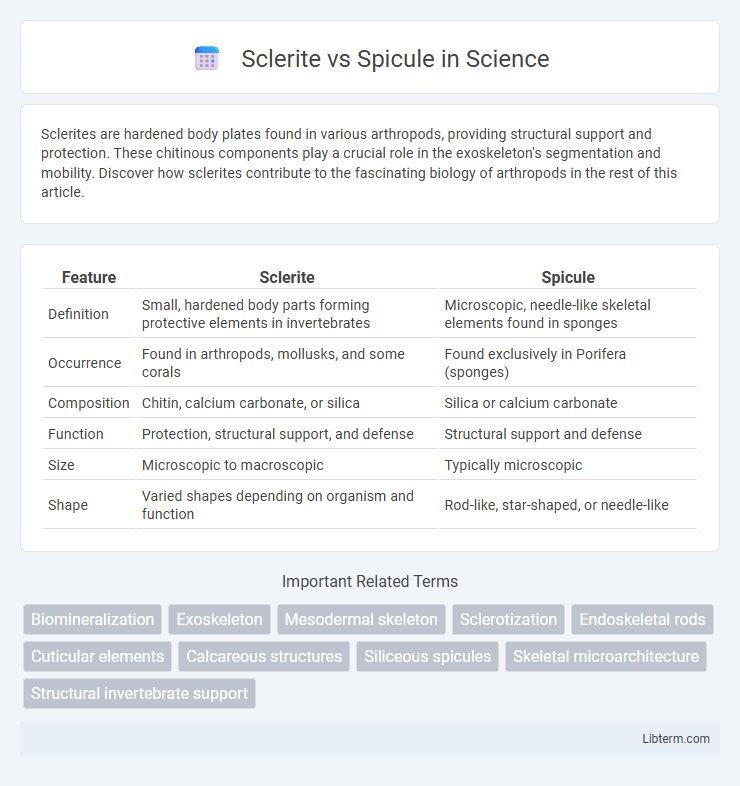Sclerites are hardened body plates found in various arthropods, providing structural support and protection. These chitinous components play a crucial role in the exoskeleton's segmentation and mobility. Discover how sclerites contribute to the fascinating biology of arthropods in the rest of this article.
Table of Comparison
| Feature | Sclerite | Spicule |
|---|---|---|
| Definition | Small, hardened body parts forming protective elements in invertebrates | Microscopic, needle-like skeletal elements found in sponges |
| Occurrence | Found in arthropods, mollusks, and some corals | Found exclusively in Porifera (sponges) |
| Composition | Chitin, calcium carbonate, or silica | Silica or calcium carbonate |
| Function | Protection, structural support, and defense | Structural support and defense |
| Size | Microscopic to macroscopic | Typically microscopic |
| Shape | Varied shapes depending on organism and function | Rod-like, star-shaped, or needle-like |
Introduction to Sclerites and Spicules
Sclerites and spicules are microscopic structural elements found in various marine invertebrates, providing support and defense. Sclerites are hardened body parts composed of calcium carbonate or chitin, commonly present in soft corals and some sponges, contributing to their rigidity. Spicules are needle-like structures made primarily of silica or calcium carbonate, integral to the skeletal framework of sponges and certain other marine organisms.
Defining Sclerites: Structure and Function
Sclerites are small, hardened body parts composed primarily of chitin or calcium carbonate that provide structural support and protection in various invertebrates, such as mollusks and arthropods. These rigid elements form part of the exoskeleton or cuticle, enhancing durability and defense against predators and environmental stress. Unlike spicules, which are often mineral-based skeletal elements found in sponges, sclerites have a more diverse composition and function across multiple phyla.
Spicules Explained: Composition and Roles
Spicules are microscopic skeletal elements found primarily in sponges, composed mainly of silica or calcium carbonate, providing structural support and defense against predators. Their shapes vary from simple rods to complex star-like formations, enhancing the sponge's rigidity and deterring predation. Unlike sclerites, which are found in soft corals and serve both protective and supportive functions, spicules are exclusively associated with sponge morphology and are key to species identification.
Key Differences Between Sclerites and Spicules
Sclerites are small, hardened body parts composed mainly of chitin or calcium carbonate, commonly found in soft-bodied invertebrates like corals and mollusks, while spicules are microscopic, needle-like structures made primarily of silica or calcium carbonate, characteristic of sponges. Sclerites function primarily as protective elements and structural support within the soft tissue, whereas spicules provide both skeletal support and defense against predators. The key difference lies in their composition, morphology, and biological roles, with sclerites often contributing to external armor and spicules forming an internal framework.
Occurrence in Nature: Organisms with Sclerites vs Spicules
Sclerites are commonly found in organisms such as mollusks, corals, and certain arthropods, where they form hardened, supportive structures or protective armor. Spicules predominantly occur in sponges (Porifera) and some marine invertebrates, serving as structural elements that provide support and deter predators. While sclerites are often calcified or chitinous fragments embedded in soft tissues, spicules are mineralized, needle-like components primarily composed of silica or calcium carbonate.
Biological Functions and Significance
Sclerites provide structural support and protection in invertebrates, particularly within the exoskeletons of arthropods and the spicules of marine sponges. Spicules contribute to the skeletal framework of sponges, enhancing defense mechanisms and facilitating water flow for filter feeding. Both structures play crucial roles in maintaining organismal integrity and ecological adaptation in their respective biological contexts.
Morphological Variations and Adaptations
Sclerites and spicules exhibit distinct morphological variations adapted to their respective biological roles; sclerites are typically hardened plates or scales composed of chitin or calcium carbonate, providing structural support and protection in arthropods and some invertebrates. Spicules, primarily composed of silica or calcium carbonate, form intricate skeletal elements in sponges, offering both mechanical support and defense against predators. These adaptations reflect evolutionary responses to environmental pressures, with sclerites enhancing exoskeletal rigidity and spicules optimizing lightweight yet resilient skeletal frameworks.
Evolutionary Perspectives: Development of Sclerites and Spicules
Sclerites and spicules represent significant evolutionary adaptations in the skeletal structures of various organisms, with sclerites primarily found in early Cambrian fauna like halkieriids and spicules prevalent in sponges and some marine invertebrates. The development of sclerites is linked to protective and supportive functions in soft-bodied organisms, contributing to the diversification of early metazoans. Spicules, constructed from silica or calcium carbonate, evolved to provide structural integrity and defense mechanisms, demonstrating convergent evolution in biomineralization across multiple phyla.
Applications in Science and Research
Sclerites and spicules serve as critical microstructural elements in marine biology and paleontology for species identification and environmental reconstruction. Sclerites, found in soft corals and some invertebrates, provide insights into evolutionary relationships and biomineralization processes through their unique composition and morphology. Spicules, primarily present in sponges, are used extensively in taxonomy, fossil identification, and materials science research due to their silica or calcium carbonate-based frameworks that inform on skeletal formation and ecological adaptations.
Conclusion: Sclerites and Spicules in Comparative Perspective
Sclerites and spicules serve as crucial structural elements in various marine invertebrates, with sclerites primarily found in soft-bodied organisms like corals and sponges, while spicules are characteristic of siliceous or calcareous marine sponges. Both contribute to skeletal support and protection, yet sclerites often provide flexibility and intricate surface texture, whereas spicules form rigid, mineralized frameworks. Understanding their differences highlights evolutionary adaptations and functional diversification in marine ecosystems.
Sclerite Infographic

 libterm.com
libterm.com